If you were stranded on a desert island, one of the things you should hope washed up on the shore is a crate of strawberries. To put in a way more of us find relatable, when the supermarket shelves are nearly bare, one of the things you should look for is strawberries.

Fresh strawberries, dried strawberries, strawberry juice, frozen strawberries, and even strawberries in jams and preserves have outstanding nutritional value. This article will tell you all the ways strawberries can fill your gaps in good nutrition and make a real difference in maintaining good health.
If you are just interested to see the exact nutritional values of strawberries, there’s a table a the bottom of this article.
Jump to:
Just the Nutrition Facts
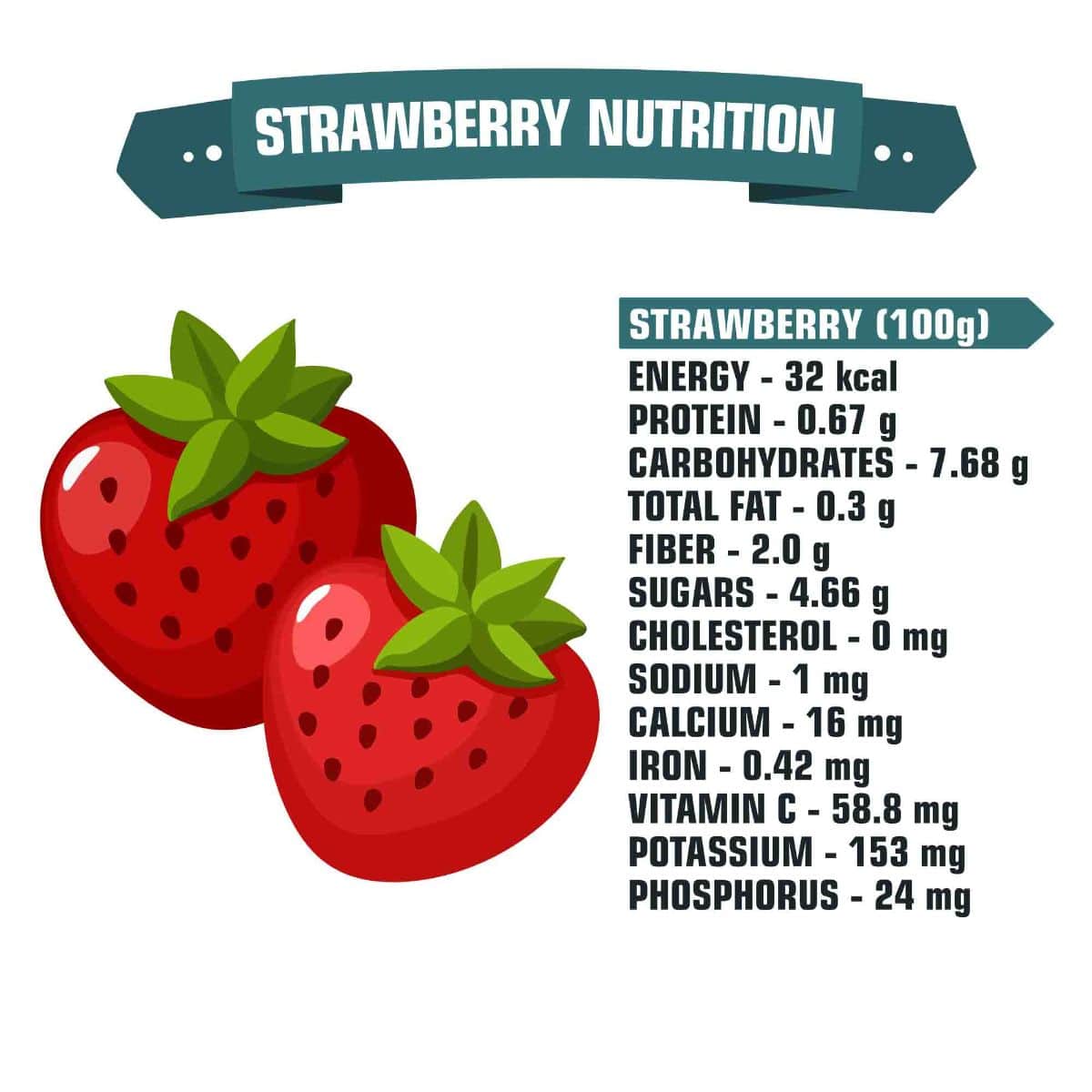
Every nutrition textbook can tell you about the low calories, high vitamin C, and significant B-vitamin content of strawberries. The nutrition facts don’t tell the whole story about strawberries, but they are a good place to start.
A cup of raw, fresh sliced strawberries weighs about 150 grams, or a little over five ounces. That cup of sliced strawberries provides a little under 49 calories in energy equivalents. (For readers outside North America, that is 49 kilocalories or a little over 200 kilojoules.) About 90 percent of the energy value in strawberries comes from healthy sugars. Strawberries contain tiny amounts of protein and fat. Of course, since your body isn’t a blast furnace, it is not going to produce exactly 49 calories of energy from a cup of strawberries. It will always be less However, that’s in the ballpark. Nobody is going to get fat eating strawberries.
Scientists tell us that no fruit you can regularly buy in markets outside the tropics has more vitamin C than strawberries. A cup of fresh strawberries contains about 150 mg of vitamin C. That’s about 150 percent of an adult’s daily need for vitamin C, but there is more to the strawberry’s antioxidant l value than just that. The human body can’t use vitamin C without certain co-factors. Early researchers called this co-factor vitamin P. Researchers in the English-speaking world don’t use that term anymore, but the polyphenols from plant foods it describes are no less essential for making vitamin C work. That’s why you don’t get all the potential benefits of vitamin C just by taking more and more and more vitamin C supplements. You also need a range of natural antioxidants from plant foods, such as strawberries, to recharge and buffer C as your body uses it.
Strawberries are a source of the B vitamin folic acid. it would be difficult to get all of your body’s needs for folic acid from strawberries, but they make an important contribution. More importantly, strawberries contain folic acid that is already in the form the body uses, methylfolate. A large number of people suffer from hereditary deficiencies in the production or activity of the methyltetrathydrofolate reductase (MTHFR) enzyme the body needs to convert “inert” folic acid into “active” folic acid it can use. Strawberries contain some of the methylfolate the body needs when it can’t produce the enzymes to make it. Millions of people who lack natural MTHFR enzymes can benefit from strawberries.
Strawberries are a good source of trace minerals. A cup of sliced, raw strawberries provides a little less than 30 percent of an adult’s daily need for manganese and measurable amounts of iron, zinc, and copper. You can’t get all your mineral nutrition from strawberries, but they help.
Strawberries provide a wide range of antioxidants. They contain phenolic acids, flavonoids, flavonols, anthocyanins, and tannins that soak up free radicals, along with the better-known free radical scavenger, vitamin C. Among the foods most often found in markets around the world, strawberries have the most antioxidant power except for pomegranates, hips harvested from dog roses, and wild blueberries. But because strawberries have a variety of antioxidants, there is no risk of overdosing the way it is possible to overdose beta-carotene and vitamin E.
Strawberries do not have to be eaten fresh to have high nutritional content. Frozen strawberries contain slightly more vitamin C than fresh. They have about more that 50 percent more calories than fresh, but that it is only 77 calories per cup (assuming the strawberries are not sugar-sweetened). They also contain about 50 percent more vitamin C than fresh, and slightly more manganese, iron, and zinc.
Fresh strawberries don’t have the highest vitamin content. A cup of fresh strawberries contains 150 mg of vitamin, but a cup of dried strawberries (which would a really large serving) contains about 730 mg of vitamin C. There are still some companies that add sugar to strawberries before drying them, but a healthier and more common approach is adding fruit juice or fruit pulp as a natural sweetener.
Strawberry leather has about 60 percent of the vitamin C and antioxidant power of fresh strawberries, but laboratory studies have surprisingly found that the antioxidant power of strawberry leather increases as strawberry leather is stored.
And everything about sweetened, frozen strawberries isn’t bad. They contain even more vitamin C than fresh strawberries or unsweetened frozen strawberries, and considerably more methylfolate. Strawberry jam loses its vitamin C content the longer it is stored unless it is stored in the refrigerator (even before the jar is opened) but other antioxidants in the jam, such as the anthocyanins that give it red color, are known to be shelf-stable.
Nutrition facts are important, but they don’t tell the whole story. When Recommended Daily Allowances and Reference Dietary Intakes were being researched decades ago, nutrition researchers hadn’t gotten around to recognizing the role a lot of plant compounds have in maintaining good health. Let’s start by taking a look at an important characteristic of strawberries that is often overlooked.
Strawberries Boost Immune Power
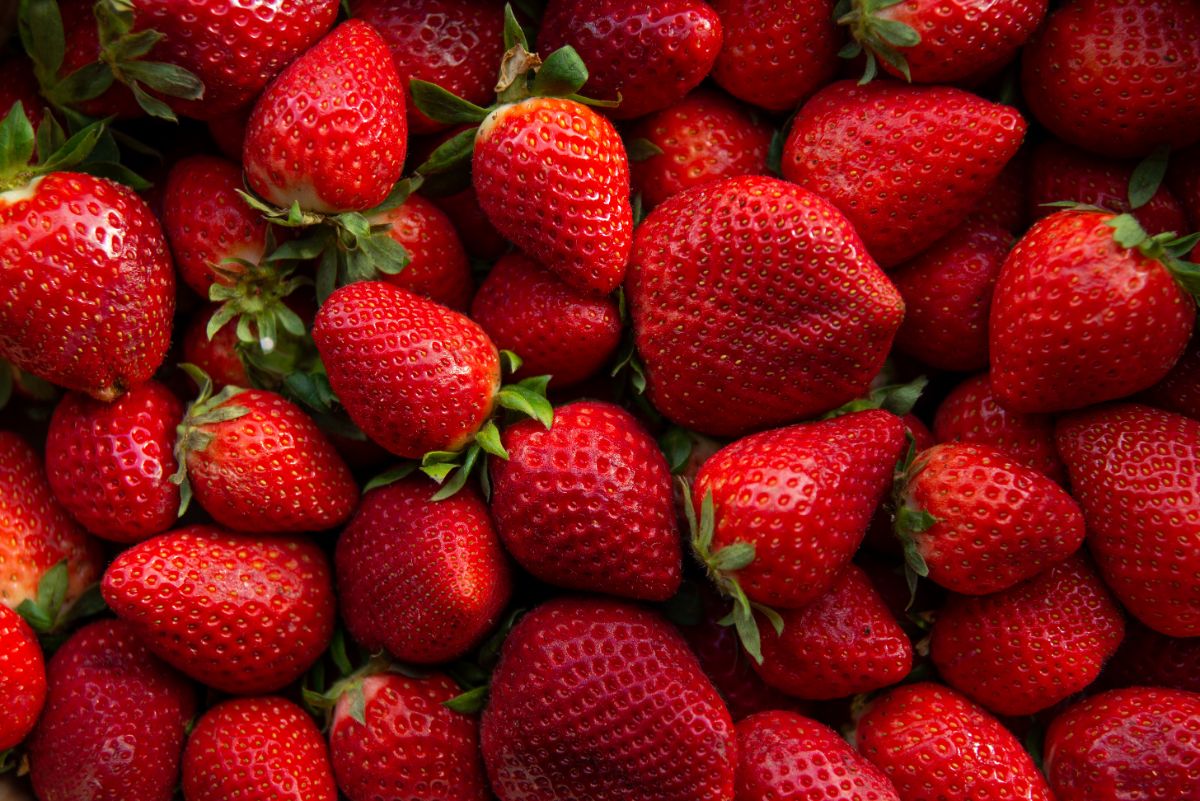
Strawberries in your diet help you avoid viral infections. During the H1N1 flu epidemic in 2009, scientists noticed that people who consumed strawberries were less likely to come down with flu. The relationship between strawberries in the diet was particularly significant for people who were obese but not morbidly obese. These were people who had a BMI between 30 and 40. People who had a weight problem who did not eat berries tended to come down with H1N1 significantly more easily than people with a weight problem who did not eat strawberries on a regular basis.
A group of scientists at the Western Human Nutrition Research Center in Davis, California set out to find out what it was about strawberries that gave the immune system more power to fight infection. They found that overweight volunteers who ate the equivalent of about two large strawberries a day made 15 to 17 percent more tumor necrosis factor-alpha, better known as TNF-alpha. Why that is a good thing may require some explanation.
TNF-alpha is a member of a group of compounds known as inflammatory cytokines. We have been conditioned to think of inflammation as a bad thing, but small amounts of TNF-alpha released by a kind of white blood cells known as macrophages goes a long way toward fighting infection. It destroys bacteria, and it is known to attack a virus called SARS.
Small amounts of TNF-alpha are a good thing, while large amounts of TNF-alpha are not. Too much of this substance is associated with a long list of serious conditions including Alzheimer’s, irritable bowel syndrome, psoriasis, and major depression. But just a little extra TNF-alpha is protective against viral infections.
The reason that obese people got an unusually large protective benefit from strawberries is that macrophages tend to get “stuck” in the small blood vessels conducting blood flow through fatty tissue. Something about strawberries enables these infection-fighting white blood cells in the rest of the body to make more of the TNF-alpha the immune system needs.
There is good evidence that strawberries would help boost the immune system, particularly in people who have weight problems. Anytime a virus is “going around,” it’s a good idea to make sure you get some strawberries in your diet. It just takes a few strawberries a day to make a difference.
Boosting immunity isn’t the only potential benefit of strawberries.
Strawberries Fight Allergies
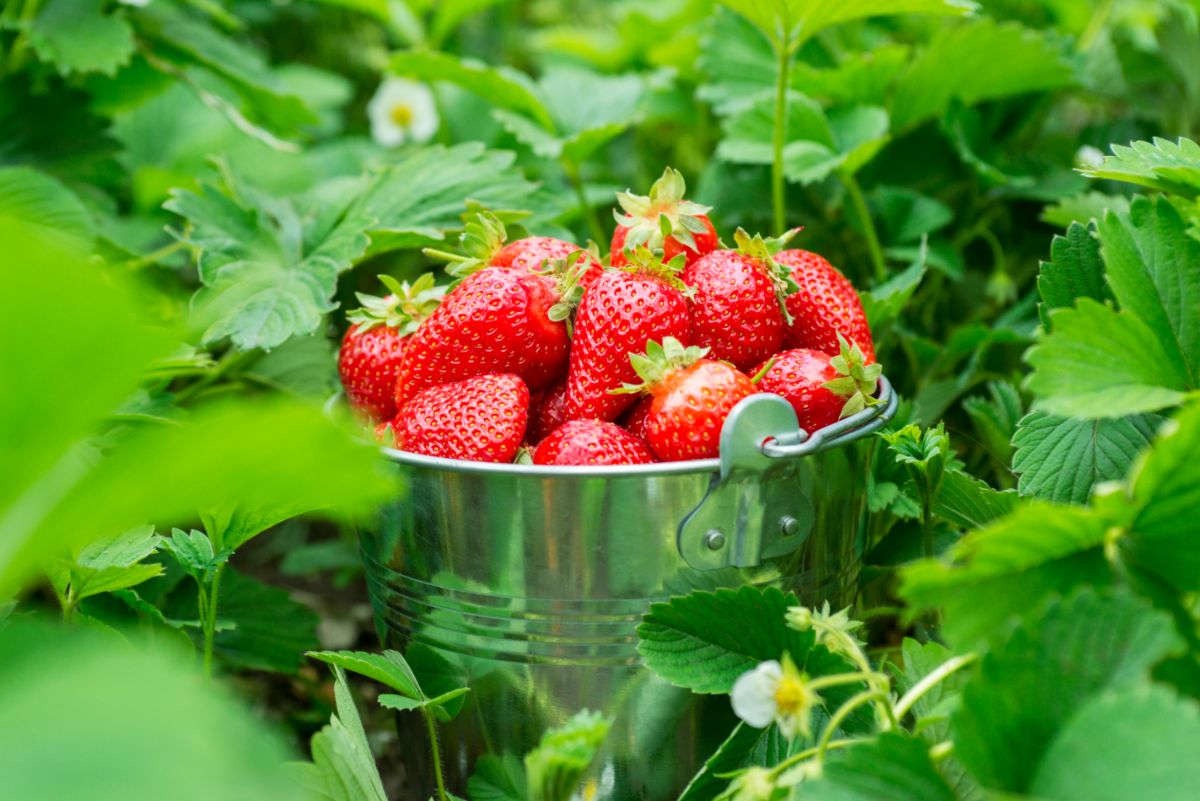
There is good reason to believe that a cup of strawberries a day helps to keep allergies away.
Strawberries are a good source of a plant chemical called quercetin. They aren’t the very best source of quercetin. That title goes to lovage leaves, followed by bee pollen, whortleberries, cowberries, apple peels, and the outer layers of onions. Except for bee pollen, these aren’t foods you are likely to have delivered from the grocery store. But of the foods you are likely actually to buy in the market, strawberries are among the best sources of the chemical.
Quercetin is a natural antihistamine. It stops the release of inflammatory compounds from mast cells in the nose and throat. It blocks the action of hyaluronidase, which breaks down the walls of capillaries, so they leak and cause swelling. When capillaries don’t break down, mast cells don’t release their histamine and allergy symptoms don’t occur.
Quercetin-rich foods aren’t medicine to treat a disease. They are nutrition to maintain good health. The time to be eating strawberries and other quercetin-rich foods is something you need to do for at least a few weeks before the beginning of your allergy season. If you wait until you have symptoms before you change your diet, you will have to wait a week or two before you see improvement.
You can read about strawberry allergy from here.
Strawberries Support Normal Blood Sugar Levels
There are some wonderful results in studies of strawberries added to the diets of diabetics — diabetic rats, that is. Indian scientists performed experiments that found adding strawberry extract to the diets of lab rats lowered cholesterol, normalized liver function, protected against kidney damage, and helped to regenerate the beta-cells of the pancreas that make insulin. Strawberries helped to offset increases in triglycerides caused by feeding the rats too much fructose. And strawberry extracts activated an enzyme called PPAR-gamma, which makes fat cells, muscle cells, and liver cells grow receptor sites that make them more sensitive to insulin, so blood sugar levels go down.
But do these strawberry benefits also apply to people?
Clinical trials of strawberries for diabetes have been done in the University of Nevada at Las Vegas (UNLV) with type 2 diabetics, diabetics whose bodies still make some insulin. The clinical studies found that adding strawberries to diets — of people — lowered blood sugar levels, lowered blood pressure, and improved measures of the progression of hardening of the arteries. We have more detailed data from the lab but there is also practical confirmation that strawberries support normal blood sugar levels.
The study at UNLV confirmed that strawberries are a great addition to the diabetic diet. Almost every diabetic can follow their doctor’s recommendations and still find room for strawberries in their diet. The thing to remember is that strawberries are not medicine. They help diabetics become healthier when those diabetics are already getting their carb consumption under control.
Strawberries Promote Cardiovascular Health
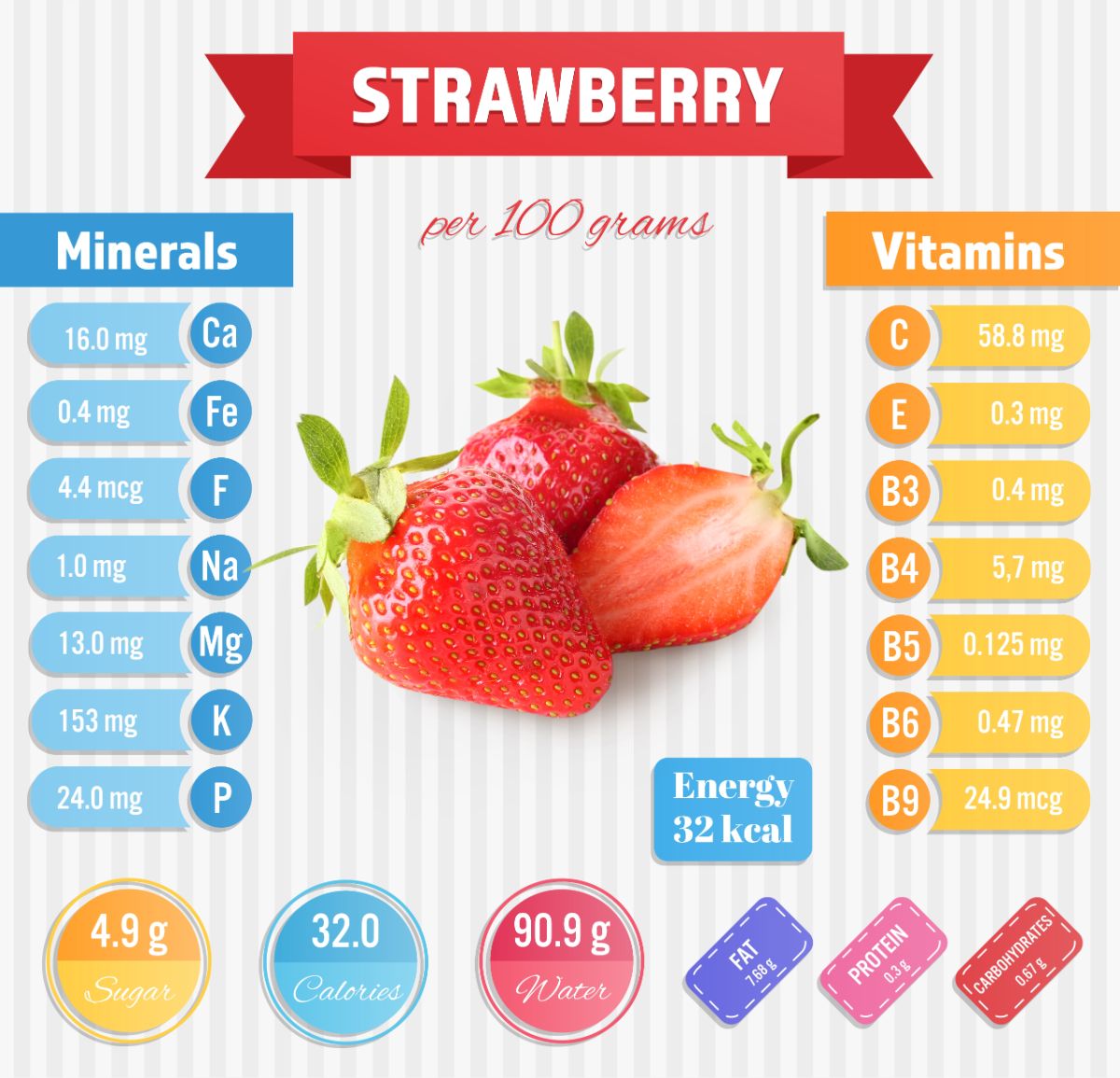
When we hear about foods that promote heart health, we naturally think of lowering inflamed arteries and lowering cholesterol. Strawberries show those cardiovascular benefits in older people. But they also promote better vascular health in children and teens.
Strawberries are like kale and spinach in that they are a useful source of nitrates (except most people think strawberries taste better). You may be familiar with the concept of nitrates and cardiovascular health. Dietary nitrates work on the same principle as the nitroglycerin pills people may place under their tongues to open blood vessels when they have chest pain. You can’t stop chest pain by putting a strawberry under your tongue. But researchers tell us that people of all ages including children have freer flow of blood through blood vessels when they consume strawberries.
Enzymes in the linings of blood vessels convert the nitrates in strawberries into a substance called nitric oxide, better known as NO. When blood vessels are exposed to NO, they gently open for greater blood flow. If you are an elderly person who has survived a heart attack, that may mean you don’t suffer as much angina. If you are a young person in good health, that may mean you can play longer and harder and have more fun. But the cardiovascular benefits of strawberries don’t stop there.
The (British) Royal Society of Chemistry published a summary of 12 research studies on the benefits of strawberries for cardiovascular health. (The link will take you directly to the table listing the studies in the article.) These studies considered how many strawberries need to be consumed for various cardiovascular benefits:
- One study found that overweight teens who ate 50 grams (a little under 2 ounces) of strawberries a day for just one week had greater NO production that leads to better blood flow. Better blood flow equals improved athletic performance and more energy. Eating 50 grams a day seems to be the minimum amount of strawberries that has this benefit. Another study that asked participants to eat 40 grams (a little less than 1-1/2 ounces) of strawberries every day failed to find a benefit.
- Another study found that adults in mid-life (average age 49 years) with “abdominal adiposity,” who had lots of belly fat, had lower LDL cholesterol and lower triglycerides after eating 50 grams of strawberries a day for 12 weeks. The study found that eating 25 grams of strawberries a day was not enough. If you are looking for volume measurements, this means that eating 1/3 of a cup of strawberries every day was enough to make a difference but eating less than one-quarter cup of strawberries isn’t.
- And a study of adults with type 2 diabetes found that eating 50 grams of strawberries every day for six weeks lowered HbA1C (that is, their “average” blood sugar levels were lower) and decreased C-reactive protein, a measure of inflammation in the arteries.
There were also studies that had volunteers eating up to a pound (454 grams) of strawberries every day. There was no harm in eating a pound of strawberries every day for weeks on end. But it is not necessary to eat that many strawberries to get the cardiovascular benefits of eating strawberries.
The benefits of strawberries don’t come from some kind of magical chemical that is released when you eat the berries and that disappears soon after. Health-promoting effects of strawberries, researchers tell us, come from your body’s interaction with the health-promoting plant chemicals in the strawberry and stay in your bloodstream at constant levels between meals.
The secret to unleashing the amazing health benefits of strawberries comes from eating just one or two servings a day. Of course, it’s always great to eat more, but just 50 grams — about one-third of a cup — eaten every day provides you with all the amazing contributions to supporting health with strawberries.
Nutritional Value of One Strawberry Serving
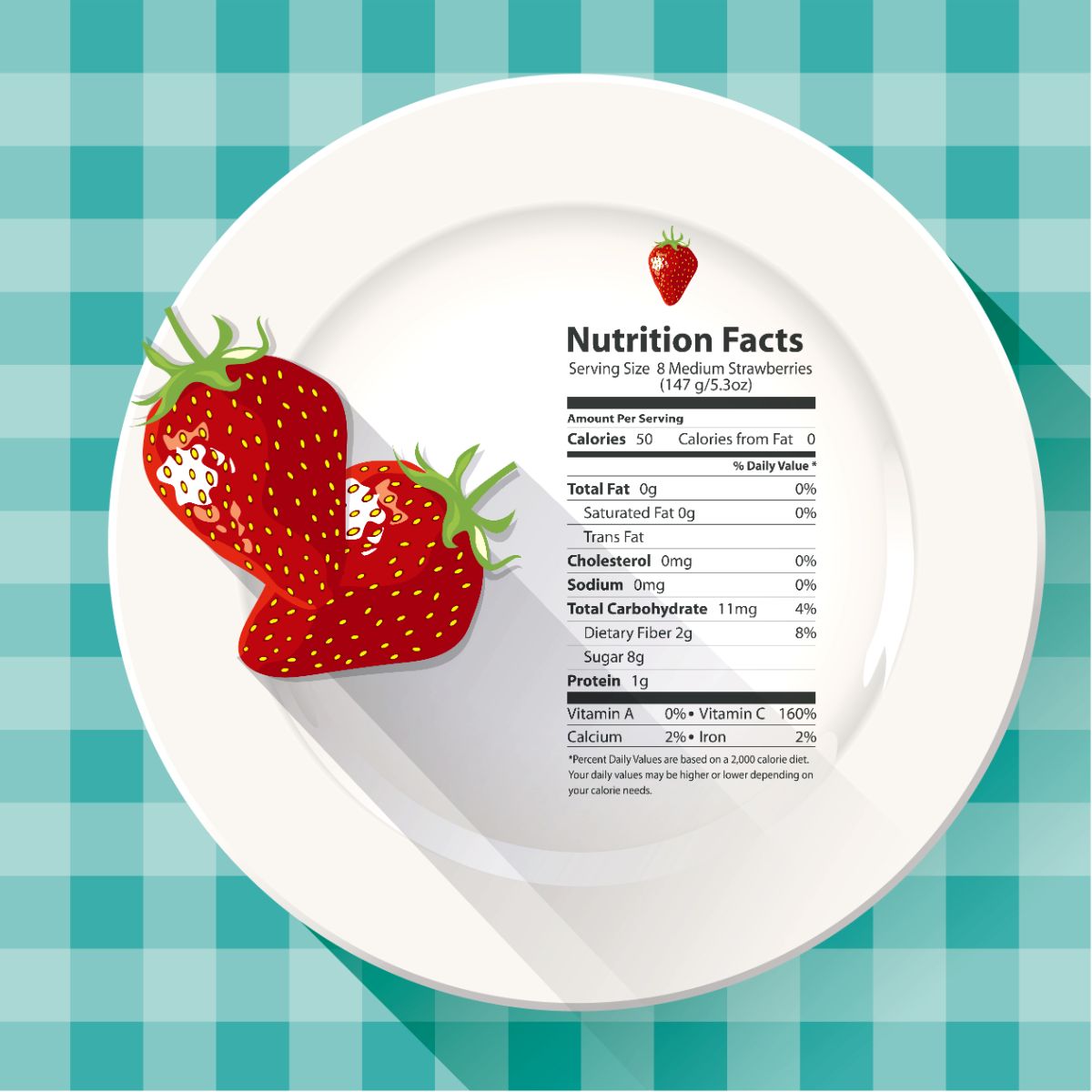
A serving of whole strawberries is generally considered to be one cup (see here for strawberry conversions). A cup of fresh strawberries will vary by weight depending on the size and specific variety of strawberry that is consumed. Also, strawberry nutrition can be affected by the quality of the soil and care given to the plants as they produced. In general, however, the following table will provide an accurate representation of the vitamins, minerals, and other components within a serving of strawberries. These strawberry nutrition facts will help you realize just how beneficial strawberries are in one’s diet!
This table contains the nutritional value of a strawberry serving, based on the standard cup-sized serving. While famous for their Vitamin C, strawberries contain a variety of beneficial compounds that will truly “do a body good.” The table is also sortable by clicking the column headings.
| Category | Nutrient | Units | 1 cup (144 g) of whole strawberries |
|---|---|---|---|
| Vitamin | Vitamin C (ascorbic acid) | mg | 82 |
| Vitamin | Thiamin | mg | 0.03 |
| Vitamin | Riboflavin | mg | 0.1 |
| Vitamin | Niacin | mg | 0.33 |
| Vitamin | Pantothenic acid | mg | 0.49 |
| Vitamin | Vitamin B-6 | mg | 0.09 |
| Vitamin | Folate | µg | 25 |
| Vitamin | Vitamin B12 | µg | 0 |
| Vitamin | Vitamin A (IU) | IU | 39 |
| Vitamin | Vitamin A (RE) | µg RE | 4.3 |
| Vitamin | Vitamin E | mg ATE | 0.20 |
| Mineral | Calcium | mg | 20 |
| Mineral | Iron | mg | 0.55 |
| Mineral | Magnesium | mg | 14 |
| Mineral | Phosphorus | mg | 27 |
| Mineral | Potassium | mg | 240 |
| Mineral | Sodium | mg | 1.44 |
| Mineral | Zinc | mg | 0.19 |
| Mineral | Copper | mg | 0.07 |
| Mineral | Manganese | mg | 0.42 |
| Mineral | Selenium | µg | 1.01 |
| Amino Acid | Tryptophan | g | 0.01 |
| Amino Acid | Threonine | g | 0.027 |
| Amino Acid | Isoleucine | g | 0.02 |
| Amino Acid | Leucine | g | 0.045 |
| Amino Acid | Lysine | g | 0.036 |
| Amino Acid | Methionine | g | 0.001 |
| Amino Acid | Cystine | g | 0.007 |
| Amino Acid | Phenylalanine | g | 0.026 |
| Amino Acid | Tyrosine | g | 0.030 |
| Amino Acid | Valine | g | 0.026 |
| Amino Acid | Arginine | g | 0.037 |
| Amino Acid | Histidine | g | 0.017 |
| Amino Acid | Alanine | g | 0.045 |
| Amino Acid | Aspartic acid | g | 0.20 |
| Amino Acid | Glutamic acid | g | 0.13 |
| Amino Acid | Glycine | g | 0.035 |
| Amino Acid | Proline | g | 0.027 |
| Amino Acid | Serine | g | 0.033 |
| Lipid | Fatty acids (saturated) | g | 0.03 |
| Lipid | 16:0 | g | 0.02 |
| Lipid | 18:0 | g | 0.006 |
| Lipid | Fatty acids (monounsaturated) | g | 0.075 |
| Lipid | 16:1 | g | 0.001 |
| Lipid | 18:1 | g | 0.073 |
| Lipid | Fatty acids (polyunsaturated) | g | 0.27 |
| Lipid | 16:2 | g | 0.16 |
| Lipid | 18:3 | g | 0.11 |
| Lipid | Cholesterol | mg | 0 |
| Lipid | Phytosterols | mg | 17 |
| Proximate | Water | g | 132 |
| Proximate | Energy | kcal | 43 |
| Proximate | Energy | kJ | 181 |
| Proximate | Protein | g | 0.88 |
| Proximate | Fat (total lipids) | g | 0.53 |
| Proximate | Carbohydrate (by difference) | g | 10.1 |
| Proximate | Fiber (total dietary) | g | 3.3 |
| Proximate | Ash | g | 0.62 |

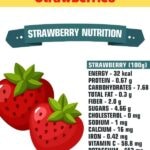

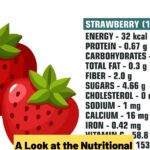

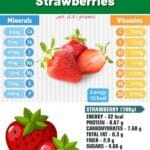




Berry Happy says
Hey, great information! I have a bit of pre-diabetes, enough that I’m testing every day, and was amazed that when I just happened to buy a pound of beautiful strawberries my blood glucose readings improved – immediately! Of course you stay on your meds, count your carbs and get your exercise but now do it with strawberries!
What also amazed me is how much better strawberries are now than in olden days (last millennium …). Bigger, sweeter, last longer at home. Terrific!